Commentary: Let's talk about the fiscal footprint of NASA's latest lunar endeavor, Artemis.
Monisha Ravisetti
June 28, 2022

NASA's Space Launch System rocket has faced a flurry of technical setbacks and fiscal complications.
Getty Images
As a science writer, I'm very familiar with the excitement of musing about humanity traveling to the moon -- I even find awe while writing about the tiniest lunar update.
A headline like "The Moon Might Have a Trace of Something That Could Potentially Be Water But Probably Not" will do it for me because, at the very least, it underscores that we're far along enough in our timeline to study worlds beyond our own. It's proof that we're on the path toward spectacular, scientific breakthroughs.
But the toil, planning and money that it takes to create -- let alone realize -- a moon mission often gets lost in translation.
Lunar travel inspires us because the difficult middle steps feel like a means to a deserving end. The remarkable cosmic finding that eventually propels medical research on Earth. The stirring realization that, somehow, we did it. That might've been what John F. Kennedy meant when he said we choose to go to the moon not because it is easy, but because it is hard.
For a moment, though, let's talk about the toil, the planning and moreover -- the money.
NASA's Artemis I moon mission is still a go, having slowly but surely waddled through its final testing phase. But as NASA is a government agency, pretty much all the money funding this lunar dream comes from taxpayer pockets -- a fact that inevitably calls into question whether moon missions are really worth the thrill, and even the scientific advancement, they give us.
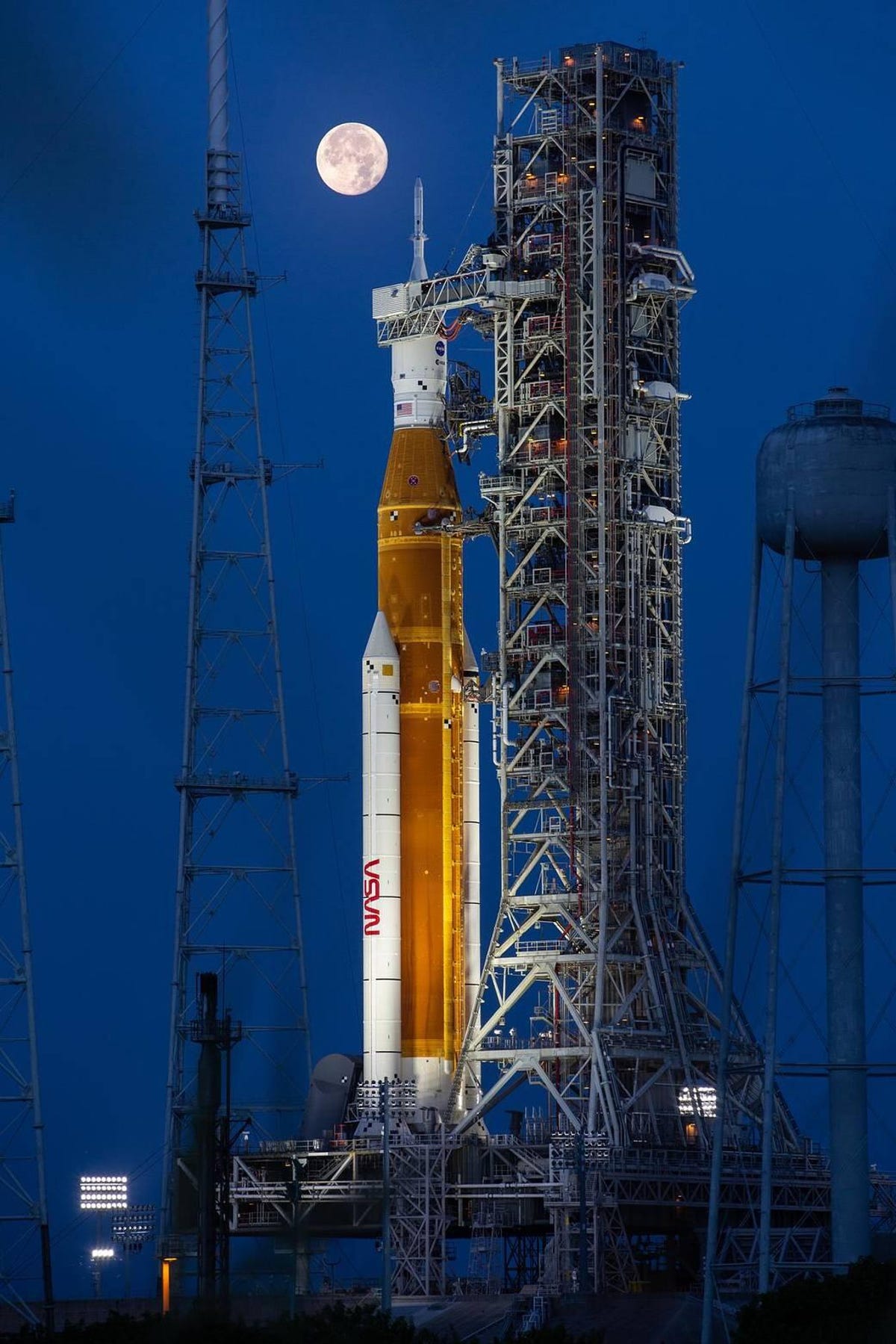
The Artemis I Space Launch System rocket, topped by the Orion spacecraft, stand tall at launch complex 39B at NASA's Kennedy Space Center in Florida on June 14.NASA/Cory Huston
Facts about lunar billions
NASA's Artemis moon rocket, slated to touch space for the very first time in 2022, was supposed to launch in 2017.
It was supposed to encompass four missions, each with a price tag estimated a decade ago at $500 million -- but a 2021 audit now projects a cost of $4.1 billion per launch. That's a difference of about $3.6 billion for every cosmic ferry. At a rate of one number per second, it'd take you over a century to count to that figure. This might explain why the same audit and NASA's inspector general bluntly label the endeavor "unsustainable."
This audit is the second of two conducted for the program, and according to the document, was motivated by the fact that Artemis is the agency's "most ambitious and costly activity." It states that Artemis "faces schedule, procurement, technical and funding risks," and therefore looked at NASA documents, systems, policies and procedures pertaining to schedule, cost, budget, operations, and other such things to evaluate those risks.
What it found was striking."I do think there are people who maybe believed it could happen, but they really in their heart of hearts had to know they were going along with something that was going to take a lot longer and cost a lot more money."
Former NASA deputy administrator Lori Garver
According to the audit, those four launches at a projected $4.1 billion a pop would be on top of the about $40 billion already spent to build Artemis equipment -- items like the rocket itself, known as the Space Launch System, and the Orion spacecraft, which will hold important devices for science exploration.
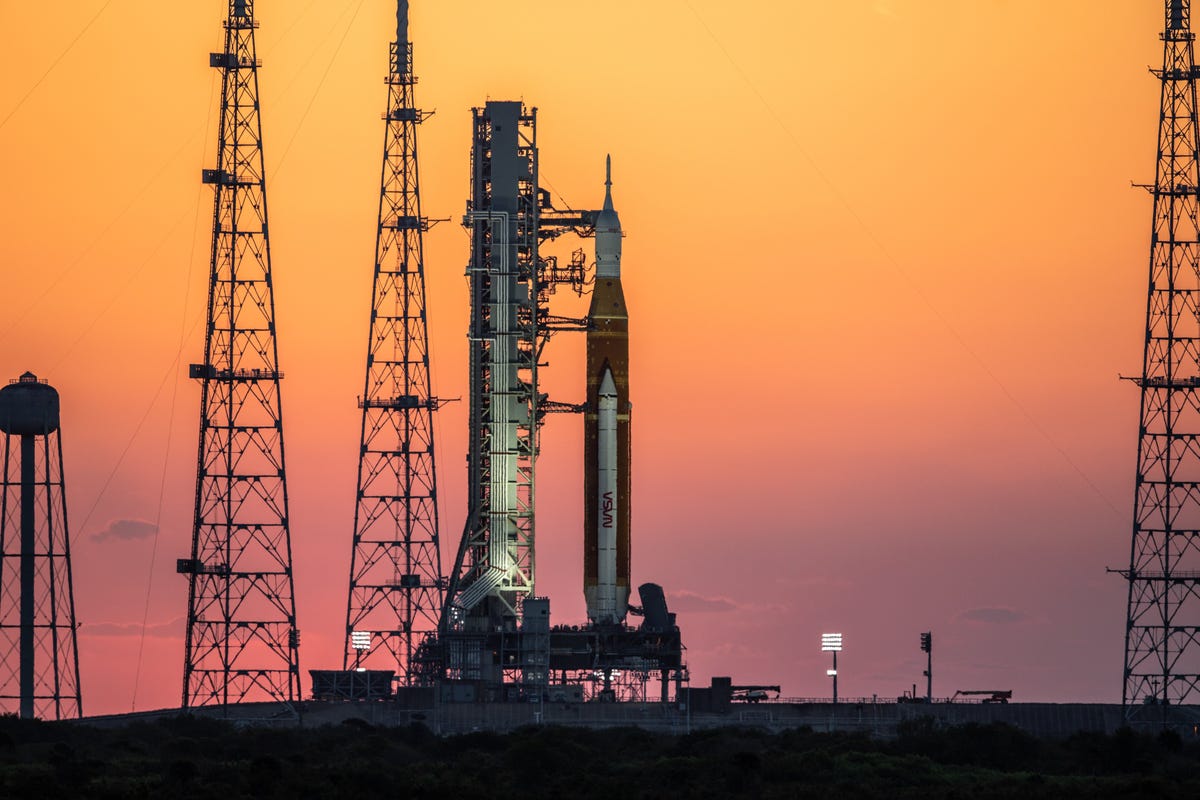
A rosy sunrise lightens the sky behind NASA's Artemis I SLS rocket in Florida. NASA
Under the Trump administration, NASA set a goal for the first Artemis crewed trip to the moon -- mission three -- for late 2024 instead of the program's initial hope of 2028, which was "just not good enough," Vice President Mike Pence said during a meeting of the National Space Council in 2019.
The accelerated timeline prompted the agency to request a "down payment" of $1.6 billion and left congressional budgeters with some big questions.
"NASA has not provided the committee with a full cost estimate despite repeated requests," US Rep. José Serrano, a Democrat from New York, said at the time -- a worry that still holds true today, according to the latest audit.
"Since NASA has already programmed the lunar landing mission for 2028," Serrano continued, "why does it suddenly need to speed up the clock by four years, time that is needed to carry out a successful program from a science and safety perspective?"
Fast-forward to now.
That 2024 deadline has since changed to 2025 and might fall even further into the future because Artemis spacesuits are behind schedule. Those spacesuits themselves will also probably end up costing a ton more than previously expected. "Since our 2017 report, NASA has spent an additional $220 million -- for a total of $420 million -- on spacesuit development," the 2021 audit said.
All in all, $93 billion
The closest we get to an "all-in-all" within the audit is "when considering the $40 billion already spent on the Artemis mission from [fiscal years] 2012 to 2020, the total projected cost through FY 2025 becomes $93 billion."
In other words, it's probably going to take at least around $93 billion to bring humanity back to the moon via Artemis.
CNET reached out to NASA for comment on audit details like delays and budget changes and was directed to the appendix section of the document where NASA management provides thoughts on the inspector general's findings.
In this section, among other things, the agency lays out some steps it plans to take in order to learn from Artemis' setbacks. For instance, it notes its intention to review requirements and specifications for streamlining the program, implementing lessons learned and measuring technical performance against the costs needed to build equipment.
The agency also offers an example of one such lesson learned: "For the SLS Boosters team, learning curve improvements reduced non-conformances by 76 percent; similarly, the SLS Core Stage team achieved a 52 percent reduction in discrepancies per 1,000 labor hours."
As management's comments echo, it's all in the name of trailblazing lunar exploration – but as it stands, remember that Artemis has yet to venture into space.
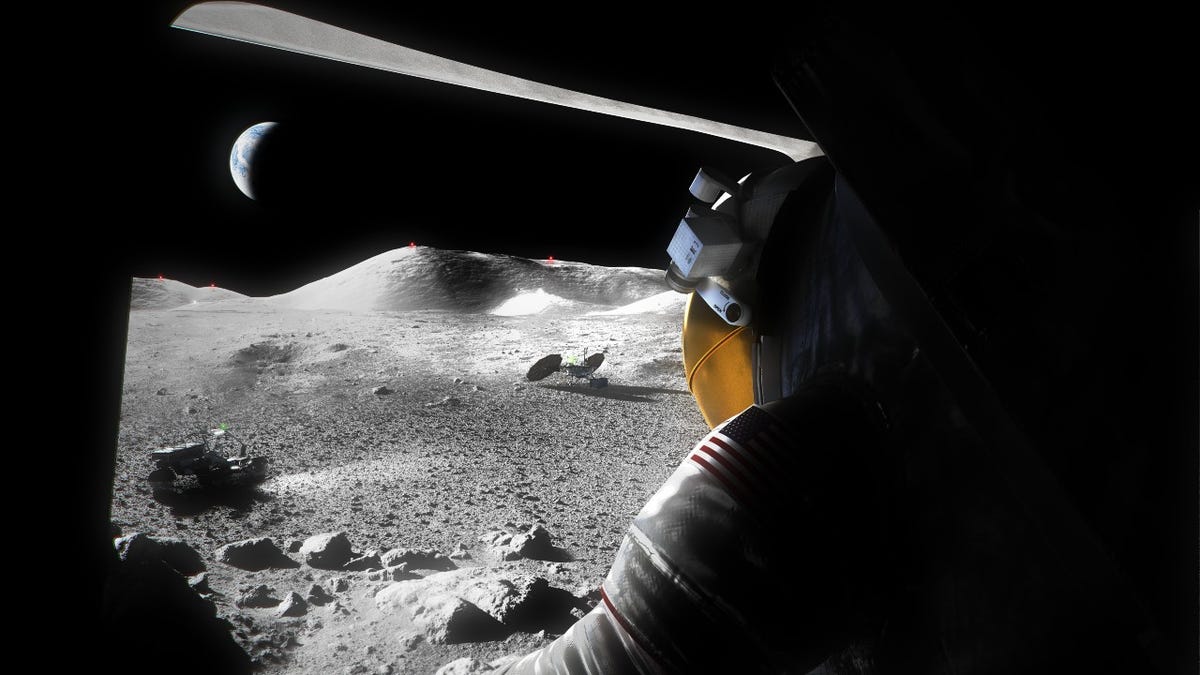
An illustration of a suited Artemis astronaut looking out of a moon lander hatch across the lunar surface.NASA
Fingers are crossed that a launch goes as planned later this year, but we still don't know whether it will. Though what we do know is that NASA's moon expedition has cost billions upon billions of extra dollars, years upon years of extra time and, according to the agency's former deputy administrator Lori Garver, breath after breath of wasted words.
"It was projected to be $500 million [per launch]" Garver, who worked at NASA between 2009 and 2013, told CNET. "I was at NASA asking these questions of the technical people, who looked me in the eye and said they could do it for that. I don't believe they thought they could. I just don't. I think they're smarter than that."
"We had things to do with that money that could have gotten us much farther," Garver said, suggesting that the $500 million per launch could've been allocated for things like astrobiology studies, which help us understand where to search for life in the cosmos. Or for research closer to home.
"Whenever I tried to push for more Earth science," such as studies related to climate change, she said, "I would often get told by the Hill" -- that is, by members of Congress -- "'that's not NASA's job. NASA is supposed to go where no one's gone before,' and I remember thinking, well, that's actually Star Trek. That's not NASA."
The Artemis wet dress rehearsal success
You might've heard that June 20 marked a milestone for Artemis, as the agency got further than ever before with the spacecraft's final -- crucial -- testing sequence.
It's called the wet dress rehearsal, and it took four tries to get to this point. A flurry of technical setbacks imperiled each of the previous three rehearsal attempts -- and even Mother Nature played a hand when lightning struck during attempt No. 1.
This is essentially the last step in preparing for the big day and involves tasks like filling the rocket with fuel (hence, "wet" dress rehearsal) and quadruple-checking that all facets are in tip-top shape. Everything but the launch itself.
Though the mission still has a few more tests to take care of, Mike Sarafin, Artemis mission manager at NASA headquarters, said in a press conference last week that celebratory hugs and handshakes were spread on Monday.
"It firmly establishes Orion and SLS as our transportation system for crew and cargo for the Artemis program," he said a day after the team's wet dress rehearsal success. "Yesterday put us on a path for Artemis I."
But, economically, Artemis' mega vehicle has caused quite the commotion.
Once estimated to cost a total of $10 billion, the SLS has left a hole of over $20 billion in taxpayer money dedicated to NASA's ambitious lunar mission and it has taken much (much) longer to complete it's testing. Charlie Blackwell-Thompson, NASA's Artemis launch director, remained hopeful in early April, saying that "this is a test, and the purpose of the test is to fully understand our systems."
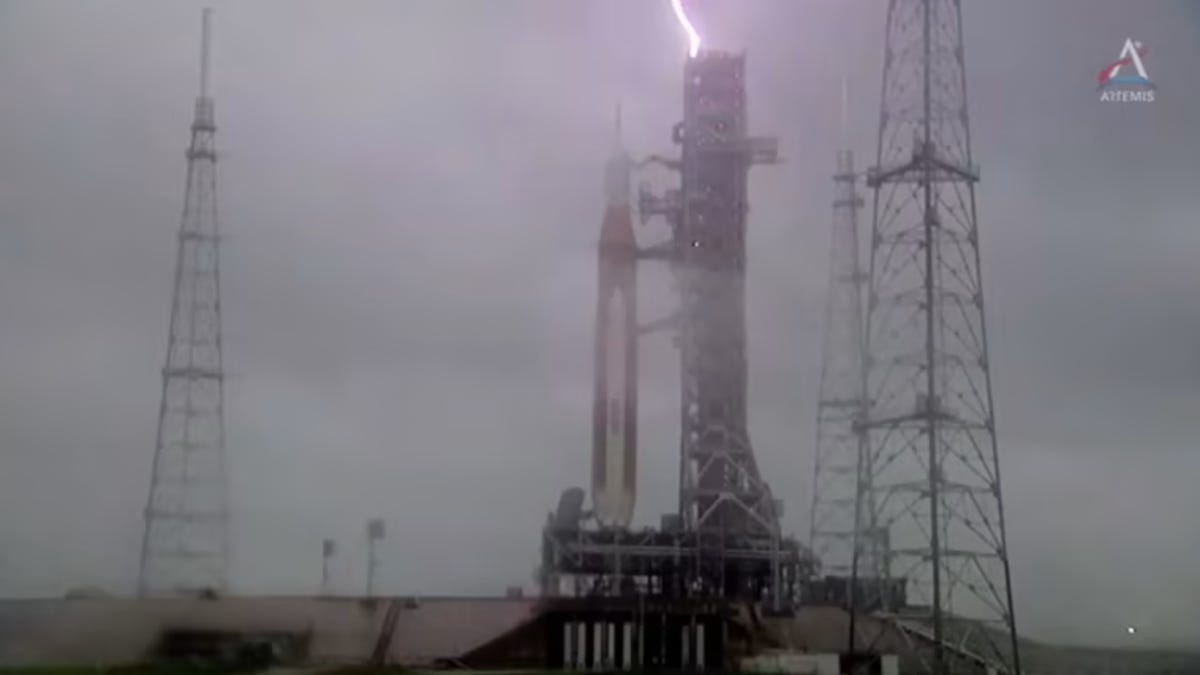
Lightning strikes tower one of Artemis I's lightning protection system.NASA
To that end, however, Garver said, "it is absolutely true that testing is all about finding problems and continuing -- but these are the same people who said they could do it in five or six years. And instead of taking five or six years, it's taking 10 or 12. So you can't have it both ways."
OK. Your mind might be overwhelmed right now. It's been a bumpy road for Artemis. But this blown-out lunar travel timeline raises a couple of pressing questions.
Why would NASA support an overidealized Artemis timeline -- if, of course, the team knew it was over idealized?
And the second might've been one lingering in your mind since you began reading this article. Should we still go forward with Artemis at all?
Introducing the 'Senate' Launch System
The Space Launch System vehicle has earned a disparaging name among critics of the Artemis program: The "Senate" Launch System.
Some experts believe the pitfall of Artemis lies in irresponsible decisions put forth by members of Congress working with the NASA bureaucracy.
"I think anyone who was honest with themselves would have agreed the system allowed the aerospace industry -- who was getting billions of dollars to build [the SLS] -- to tell Congress they could do it by that time," Garver said, explaining that the industry knew it'd be paid the same amount every year, regardless of delays. "There was a reverse incentive."
NASA Inspector General Paul Martin, who led the recent audit, even told CNBC, "We saw that the cost-plus contracts that NASA had been using to develop that combined SLS and Orion system work to the contractors' rather than NASA's advantage." Cost-plus contracts basically promise that contractors get paid for all costs, plus a fee.
He called out Boeing, which was contracted to build the SLS, for what he described as "poor planning and poor execution."
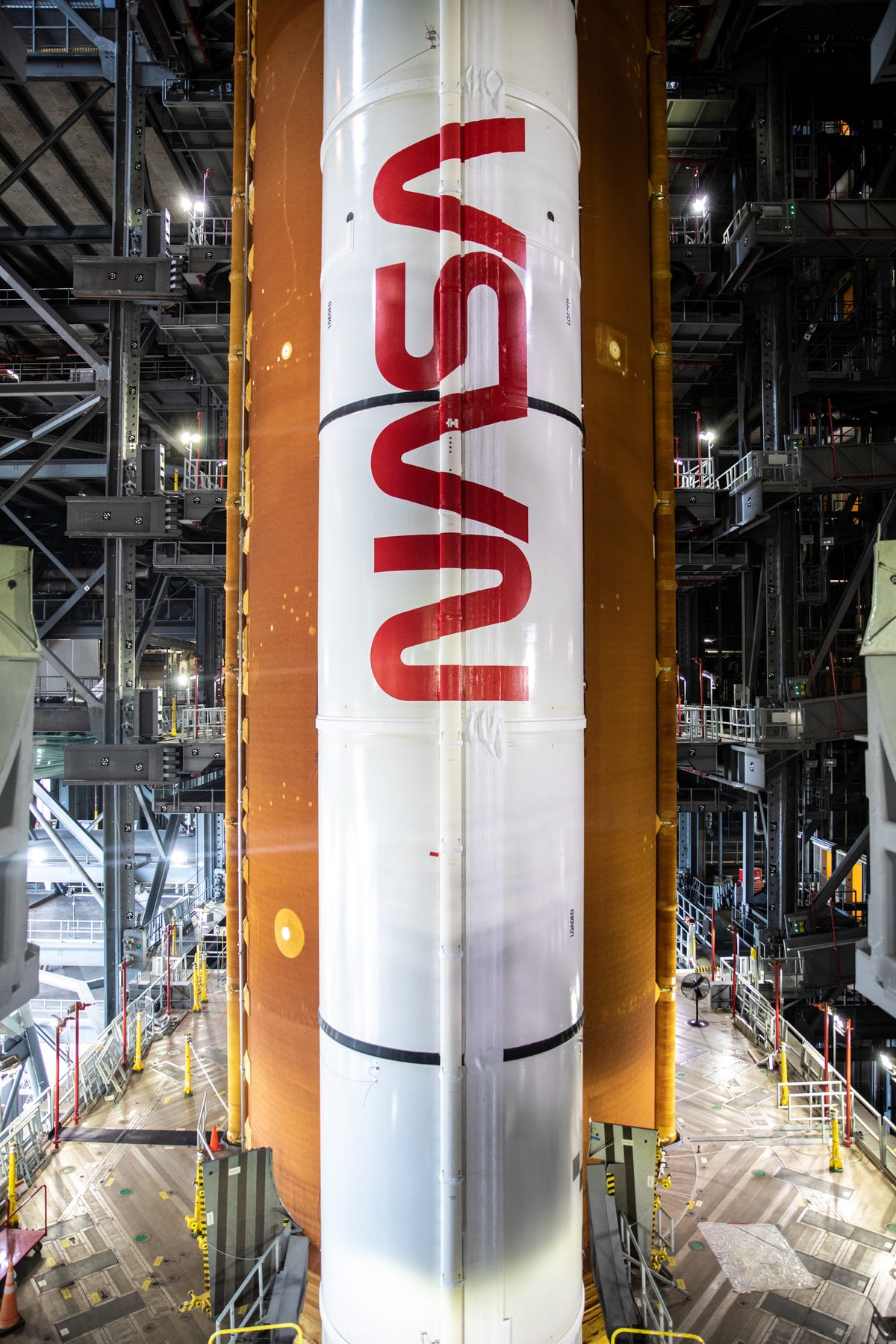
NASA's '70s-vintage worm logo fully emblazoned across the Artemis I SLS boosters.
NASA/Kim Shiflett
When asked for comment on these high SLS construction costs, Boeing told CNET, "When adjusted for inflation, NASA has developed SLS for a quarter of the cost of the Saturn V and half the cost of the Space Shuttle," and "SLS, the Orion spacecraft and Exploration Ground Systems necessary for the Artemis missions have consumed less than the average annual spending on Space Shuttle operations, which is the sustained human space flight investment level for the system they were intended to succeed."
Plus, it's worth considering that SLS building timelines might have been a bit unpredictable because the last few years have been anything but normal – COVID-19 shutdowns affected spacecraft manufacturing, and a few natural disasters impacted locations where the rocket was kept.
But looking to the past, Garver said, "Congress and industry and many in NASA have done this before. They go along with the narrative just to get a program started, knowing it will be hard to cancel."
As an example, she pointed to what we now know as the International Space Station. Back in the late '80s, when President Ronald Reagan dubbed it "Space Station Freedom," it was announced as an all-American space hub and was initially going to have a price tag of $8 billion. By 2010, after it had become an international project, overall estimates of its cost, to all participating countries, was pegged at $100 billion.
Though cost increases were to be expected as the scope of the project expanded and the ISS itself grew more efficient, that's exactly what tends to happen with timelines and budgets for big space projects.
"I do think there are people who maybe believed it could happen," Garver said of Artemis' initial timeline and budget. "But they really in their heart of hearts had to know they were going along with something that was going to take a lot longer and cost a lot more money."
In a world of reusable rockets, Artemis doesn't have one
SpaceX, Blue Origin, you name it. Everyone involved in the space game wants to craft the ultimate recyclable rocket. One that you can fly to space, then bring back home like the car sitting in your driveway.
The goal is to create cheaper, greener versions of space travel. But in this world of reusable rockets, the Artemis vehicle isn't one. "Guess what the benefit is supposed to be?" Garver said. "Cheaper; faster."
But for an example of cheaper and faster, there's Starship, the reusable rocket that Elon Musk's SpaceX is building. It's cost $5 billion so far and is arguably nearing the same point as Artemis' SLS, if it's not further along. The SLS has cost something like $23 billion so far. To be clear, Starship also hasn't yet made it to space, so it's story is still being written too.
If Starship does find success quicker than NASA's SLS, Garver suggests it might be the case that Musk's private space organization could light the way for future moon missions -- it's already poised to help with Artemis III's crewed mission and has garnered a lot of praise for its Falcon 9 successes, though notably, Falcon 9 trips have only gone as far as low Earth orbit.
When asked for comment on these high SLS construction costs, Boeing told CNET, "When adjusted for inflation, NASA has developed SLS for a quarter of the cost of the Saturn V and half the cost of the Space Shuttle," and "SLS, the Orion spacecraft and Exploration Ground Systems necessary for the Artemis missions have consumed less than the average annual spending on Space Shuttle operations, which is the sustained human space flight investment level for the system they were intended to succeed."
Plus, it's worth considering that SLS building timelines might have been a bit unpredictable because the last few years have been anything but normal – COVID-19 shutdowns affected spacecraft manufacturing, and a few natural disasters impacted locations where the rocket was kept.
But looking to the past, Garver said, "Congress and industry and many in NASA have done this before. They go along with the narrative just to get a program started, knowing it will be hard to cancel."
As an example, she pointed to what we now know as the International Space Station. Back in the late '80s, when President Ronald Reagan dubbed it "Space Station Freedom," it was announced as an all-American space hub and was initially going to have a price tag of $8 billion. By 2010, after it had become an international project, overall estimates of its cost, to all participating countries, was pegged at $100 billion.
Though cost increases were to be expected as the scope of the project expanded and the ISS itself grew more efficient, that's exactly what tends to happen with timelines and budgets for big space projects.
"I do think there are people who maybe believed it could happen," Garver said of Artemis' initial timeline and budget. "But they really in their heart of hearts had to know they were going along with something that was going to take a lot longer and cost a lot more money."
In a world of reusable rockets, Artemis doesn't have one
SpaceX, Blue Origin, you name it. Everyone involved in the space game wants to craft the ultimate recyclable rocket. One that you can fly to space, then bring back home like the car sitting in your driveway.
The goal is to create cheaper, greener versions of space travel. But in this world of reusable rockets, the Artemis vehicle isn't one. "Guess what the benefit is supposed to be?" Garver said. "Cheaper; faster."
But for an example of cheaper and faster, there's Starship, the reusable rocket that Elon Musk's SpaceX is building. It's cost $5 billion so far and is arguably nearing the same point as Artemis' SLS, if it's not further along. The SLS has cost something like $23 billion so far. To be clear, Starship also hasn't yet made it to space, so it's story is still being written too.
If Starship does find success quicker than NASA's SLS, Garver suggests it might be the case that Musk's private space organization could light the way for future moon missions -- it's already poised to help with Artemis III's crewed mission and has garnered a lot of praise for its Falcon 9 successes, though notably, Falcon 9 trips have only gone as far as low Earth orbit.

Starship prototype SN15 during its successful test flight.SpaceX
"There's no way to use it for something else, unfortunately," Garver said. "Those sunk costs would be a waste -- it's not easy to say, and the people who worked on it are not bad. This was a design flaw."
However, the SLS' recent checkpoint with the wet dress rehearsal completion offers some hope that this worst-case scenario won't happen.
Further, it would be remiss to ignore the feeling that NASA's intrinsic value transcends what private space companies have right now. Undoubtedly, the agency's highly trained astronauts will uniquely know what to do once we do get to the moon and possess valuable insights from the Apollo missions that began our lunar saga -- insights that SpaceX hasn't yet proven to hold.
Traveling there via the SLS, or even the Starship for that matter, is just one piece of the puzzle. But that is the piece we have to worry about right now.
It's only a matter of time before we see how the rest of the Artemis story will unfold. Artemis I's uncrewed mission will be followed by several others, including a crewed mission that takes the first woman and first person of color to the moon and later others to build lunar space stations, bases, something called the "Lunanet" (think of it as a moon-based internet) and even pave the way for Mars missions down the line.
Regardless of who gets there first, and aboard which vehicle, Kennedy's Apollo speech still resonates:
"We choose to go to the moon in this decade and do the other things, not because they are easy, but because they are hard, because that goal will serve to organize and measure the best of our energies and skills, because that challenge is one that we are willing to accept, one we are unwilling to postpone, and one which we intend to win, and the others, too."
But even as we all feel lunar butterflies, we might want to consider the costs incurred along the way.
"I am also confident we all have the same shared goal – a robust human spaceflight program. But, as the saying goes, the devil is in the details," US Rep. Brian Babin, a Republican from Texas, said during a House space subcommittee hearing in March.
"We are still waiting on those details."
No comments:
Post a Comment